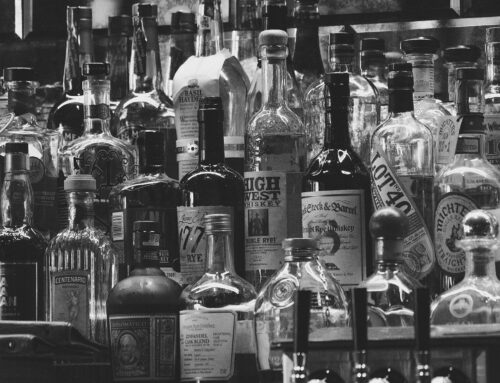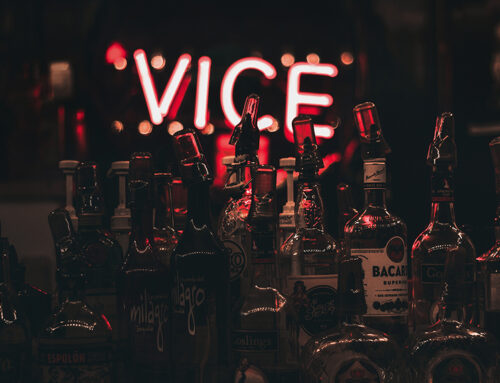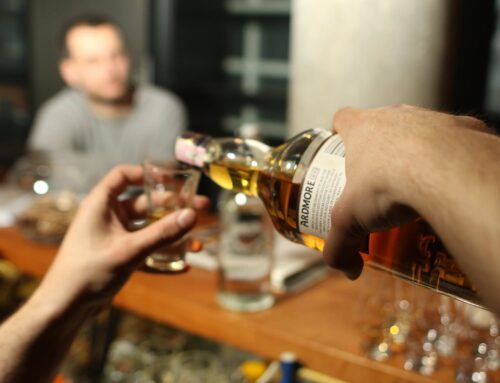BASIC LIQUEUR TYPES
Chocolate
- Chocolate Suisse (107)
- Godiva Dark Chocolate (106)
- Swiss Chocolate Almond (106)
Coffee
- Copa De Oro (111)
- Kahlua (116)
- Tia Maria (109)
Cream
- Amarula (105)
- Bailey’s (106)
- Haagen Dazs (107)
- Myer’s Rum Cream (105)
Creme de Menthe
- Peppermint Schnapps (103-112 Varies)
- Benedictine (107)
- Chambord (113)
- Chartreuse(99)
- Drambuie (108)
- Galliano (110)
- Glayva (109)
- Irish Mist (104)
- Parfait A’mour (113)
- Southern Comfort (97)
- Yukon Jack (100)
CHOCOLATE LIQUEURS
These liqueurs are percolated from cocoa and vanilla beans using a base of neutral spirits. The most popular in this class are the light (clear) and dark (brown) creme de cocao’s. In recent years many distillers have started making liqueurs that combine chocolate with such traditional flavours as cherry, coconut and mint.
BRANDS
CHOCOLATE SUISSE
A chocolate flavoured Swiss liqueur produced with miniature squares of chocolate afloat in the bottle.
GODIVA DARK CHOCOLATE LIQUEUR
Since 1926 these famous Belgian chocolatiers have made this liqueur with black cherries, orange peels, coffee and unsweetened dark chocolate.
SWISS CHOCOLATE ALMOND
A rich, smooth liqueur that combines many cocaos, almonds and vanilla.
COFFEE LIQUEURS
Percolation is the usual method of producing this very popular class of liqueurs. The coffee beans create a distinct, rich taste and a strong aromatic fragrance.
BRANDS
COPA DE ORO
This imported coffee liqueur is made with Mexican beans and some of the world’s most delicate and rare spices. A new player but it is the fastest growing product in this category.
KAHLUA
For years this has been the number one imported liqueur. It’s made from mexican coffee beans, neutral spirits and sugar syrup.
TIA MARIA
Jamaican coffee extracts and a neutral spirit base. It is lighter in density than Kahlua and is therefore best suited for shaken rather than layered shooters.
CREAM LIQUEURS
Traditionally, these liqueurs were made with Irish whiskey, fresh dairy cream from the southern coast of Ireland, chocolate and just a touch of coffee. Some relative newcomers have altered this recipe by utilizing different spirit bases. The results have been nothing short of spectacular.
Shake well before using and refrigerate after opening.
BRANDS
AMARULA
South African entry, made with the riped fruit of the Marula tree.
BAILEY’S
The traditional Irish cream liqueur.
HAAGEN DAZS
A tasty blend of Dutch cream and a cognac base.
MYER’S RUM CREAM
Here, it’s a smooth caramel taste derived from a base of Jamaican rum that makes it a personal favorite for shooters, cocktails and coffee drinks.
CREME DE MENTHE LIQUEURS
This refreshing liqueur holds the cool flavour of natural mint and is available in white (clear) and green.
Over the last decade, minty creme de menthe liqueurs have given way to lighter “schnapps”, in particular flavoured ones like apple and peach. Peach schnapps created quite a stir in the liquor industry back in 1985, when over one million cases were shipped – the greatest number ever for a new product.
Other flavours available besides peach, include root beer, licorice, pear, raspberry, passion fruit and even kiwi. Incidentally, “schnapps” in german refers to any water-white distilled beverage alcohol.
PEPPERMINT SCHNAPPS
Both dry and water-white, it has a very pleasant peppermint flavour. Schnapps is lighter-bodied and not as sweet as Creme de Menthe but it is ideal for most recipes.
FAVOURITE FLAVOURS
Peach
Butterscotch
Pear
Chocolate
FRUIT LIQUEURS
The flavouring is created by infusion or maceration of fruit or fruit spirits. The base can take the form of brandy, rum or whiskey but in most cases a neutral alcohol is used.
POPULAR TYPES
All the major distillers offer a wide selection of fruit liqueurs. The quality can vary greatly but most are fun to experiment with. Some of the more interesting are:
APRICOT
Well balanced and versatile, Apricot has a slight vanilla overtone.
BANANA
A sweet, yellow liqueur with the full flavour of ripe bananas. A must for any shooter bar.
COCONUT
Delicious and tropical, coconut is often made with a rum base.
MELON
Usually bright green in colour, this liqueur has the interesting taste of melon and honeydews.
A tasty blend of Dutch cream and a cognac base.
MYER’S RUM CREAM
Here, it’s a smooth caramel taste derived from a base of Jamaican rum that makes it a personal favorite for shooters, cocktails and coffee drinks.
LICORICE LIQUEURS
These sweet, delicately aromatic liqueurs all have a pleasant licorice flavour. The major type, Anisette, derives its licorice quality from anise seeds but additional flavourings can be used (for example citrus peels) to complete the final taste. Anisette is produced all over the world and the taste will vary greatly with the extra flavourings used by each distiller.
ASSOCIATED TYPES
SAMBUCA
An Italian creation similar in taste to Anisette but tempered with the seeds of the witch elderberry bush in a brandy base. For those in the know – there is really only one brand to use; Luxardo.
PERNOD
The liqueur is derived from the distillation rather than the maceration of the anise seeds. A fine french brandy base forms a smooth overall taste.
OUZO
A potent Greek creation that’s dry and fairly harsh, with a high alcohol content. BEWARE – Don’t smoke and keep away from open flame.
NUT LIQUEURS
Nut liqueurs use a variety of fruit pits, kernels and nuts as their primary flavouring source. Other items serve as secondary sources such as fruit pulp, citrus, peels, chocolate, coffee, vanilla and herbs. They are usually infused or macerated.
POPULAR TYPES
AMARETTO
A smooth, naturally sweet almond taste created from peach and apricot pits and, of course, almonds. Originally from Saronno, Italy, several are now made in North America.
FRANGELICO
Another Italian creation that uses hazelnuts with flowers and berries as the flavouring sources.
PISTACCHIO
An Italian cream liqueur made with pistacchios.
ORANGE LIQUEURS
The orange flavouring is usually made from a mixture of various orange peels infused in neutral spirits. Orange liqueurs or Triple Sec’s differ in their degree of tanginess (citrus content), alcohol content, dryness and spirit base.
BRANDS
COINTREAU
A brand name, Triple Sec is made from a blend of bitter and sweet orange peels from the West Indies. It is French in origin and white (clear) in colour.
GRAND MARNIER
A bottle of G.M. is sold every second of every day and the reason for these healthy sales is quality. Every bottle is washed with a form of unsweetened G.M. to prevent any dilution and each label is quality checked for position by laser. With this kind of intense commitment to excellence it’s easy to see why only the finest cognac and the best bitter, green, orange peels from Haiti are used.
GRAND CURACAO
Similar to Grand Marnier, Curacao has more sugar, sweet oranges and spices. It’s named after the West Indian island where the oranges originate.
OLD FAMILY RECIPES
These brands have been popular for ages in their homelands and today enjoy international recognition and acceptance.
BRANDS
ADVOKAAT
A rich, sweet Dutch eggnog of low alcohol content, flavoured with coffee and a variety of spices including vanilla.
BENEDICTINE
French monks have been making this liqueur since the 1500’s. This secret formula of bark, roots and over 200 herbs is only known to three people at any one time. It’s ingredients are macerated in brandy, distilled twice and aged in oak casks.
CHARTREUSE
Another well kept secret recipe that contains the flavourings of over 130 herbs, flowers and fruits. During the French Revolution, many Carthusian monks took their precious secret to the grave rather than reveal it to their captors.
DRAMBUIE
The name translates to “the drink that satisfies”. This legendary Scottish recipe of scotch, heather, honey and herbs was given to the MacKinnon family by Bonnie Prince Charlie for saving his life after the fall of the Stuarts (1745).
GLAYVA
A sweet, smooth mixture of scotch, honey and herbs, similar to Drambuie and also from Scotland.
IRISH MIST
This mixture of Irish Whiskey, honey, herbs and clover has been known for over 1000 years as “Heather Wine”.
PARFAIT A’MOUR
A sweet concoction of violets, rose petals, vanilla and citrus peels make Parfait A’mour a must for any shooter bar. The name translates to “perfect love” and it was once the preferred drink of Parisian prostitutes.
LIQUORE GALLIANO
A secret Italian recipe of 80 spices, herbs and fruits that produces a taste similar to a mild yet thick anisette.
SOUTHERN COMFORT
A U.S. creation of peaches, oranges and herbs with a neutral base. Made famous in the 1960’s as Janis Joplin’s favourite liqueur.
YUKON JACK
“The Black Sheep of Canadian liquors” is made with a blend of Canadian rye whiskeys, herbs and subtle citrus flavours.
MISCELLANEOUS SPIRITS
CHAMBORD
Chambord is a French liqueur made of red and black raspberries, vanilla from Madagascar, citrus, honey, and cognac.
COGNAC
The premier brandy of France that comes from a limited area surrounding the ancient city of Cognac. Only brandy distilled from grapes grown within this area may be called cognac.
BOURBON
This corn whiskey has been called “The Great Spirit Of America”. There are strict requirements for a whiskey to be called a bourbon. For instance, the grain mixture must contain 51% corn and the final product must be aged a minimum of two years in charred oak casks.
TEQUILA
Although a relative new export for Mexico (1947), it has been around Mexico City since the days of the Aztecs. Tequila is distilled from the mezcal plant and it bears no relationship to the hallucinogen mescaline nor to the plant Mescal. This fable still continues today but tequila is no more a drug than other liqueurs or liquors.
Tequila comes in white (clear) and gold, which gets its colour from aging in oak casks.



